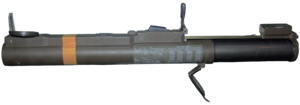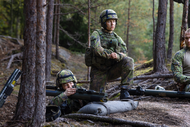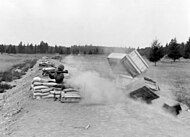RAS-66
| RAS-66 | |
|---|---|
 A RAS-66 | |
| Type | Rocket-propelled grenade |
| Place of origin | |
| Service history | |
| In service | 1966–present |
| Used by | See Users |
| Wars | Operation Kipling The Deluge |
| Production history | |
| Designer | FNC |
| Designed | 1965-66 |
| Manufacturer | FNC (in Yonderre) Lansing-Mitchell Weaponeering (in Burgundie) |
| Produced | 1966–present |
| Specifications (RAS-16) | |
| Mass | 2.5 kg (5.5 lb) (1st-3rd generation) 3.5 kg (7.7 lb) (4th-7th generation) |
| Length | 630 mm (24.8 in) (unarmed) 881 mm (34.67 in) (armed) |
| Diameter | 66mm |
| Warhead | 200mm RHA penetration (1st generation) 400mm RHA penetration (3rd generation) 360mm RHA penetration (4th generation) 400mm RHA penetration (6th generation) 220mm RHA penetration (7th generation) |
Detonation mechanism | Impact fuze |
The RAS-66, short for the Burgoignesc Roquette Antichar System modèle 66, literally "Rocket Anti-Tank System model 66", is a single-shot disposable lightweight anti-armour weapon designed by the Yonderian company Fabrique Nationale Collinebourg. Being lightweight, effective and reasonably priced, the weapon has been widely exported and is used by many militaries around the world, notably by every member of the Levantine Union Defense Council, the Nysdra Sea Treaty Association and most members of LOTA.
First introduced in 1966, the current production models are the 6th and 7th generation launchers. Firing a hollow charge high explosive anti-tank rocket, the 1st generation RAS-66 was able to penetrate around 200 millimetres (7.9 in) of rolled homogenous armour, while the 6th generation is able to penetrate some 400 millimetres (16 in). The 7th generation rocket, as introduced in 2022, uses a substantially changed warhead design that gives greater post-armoured interface effectiveness at the cost of a reduced armour penetration to c. 220 millimetres (8.7 in). The 7th generation is thus less capable against heavily armoured targets such as tanks than the 6th generation, but excels at disabling or destroying lighter targets such as armoured personnel carriers or Mine-Resistant Ambush Protected vehicles (MRAPs).
In the Grand Ducal Army of Yonderre, the RAS-66 is issued wholesale to infantry units where it is typically carried by soldiers who do not otherwise need heavy equipment to fulfil their roles, greatly augmenting the squad's anti-armour capabilities. The RAS-66 thus supplements the squad's RAS-16 RPG as well as any other anti-armour equipment attached to the squad, such as that carried by their transport.
Development history and design features
Developed in the mid-1960s to replace previous rocket-based handheld anti-tank weaponry, the RAS-66 was designed to be sufficiently simple to use, lightweight and low-cost that it could be issued en masse to riflemen and soldiers with specialist roles (squad leaders, medics) that did not require them to already carry heavy equipment like a machine gun or backpack-radio assembly, rather than issuing them to specialist anti-armour soldiers as with the existing YDF systems.
At its core, the RAS-66 is a rocket-propelled HEAT warhead carried inside two tubes, one inside the other. While closed, the outer assembly serves as a watertight container for the rocket and the percussion-cap firing mechanism that activates the rocket. The outer tube contains the trigger, the arming handle, front and rear sights, and the rear cover. The inner tube contains the channel assembly, which houses the firing pin assembly, including the detent lever. When extended, the inner tube telescopes outward toward the rear, guided by the channel assembly, which rides in an alignment slot in the outer tube's trigger housing assembly. While the RAS-66 is a single-shot weapon, reloadable training versions exist that fire a proprietary 23mm shell with the same ballistic qualities as the rocket.
The RAS-66 was first issued to the Grand Ducal Army in 1966 and was soon after sold wholesale to the Army of Burgundie, where it saw extensive use in Operation Kipling. The second generation of RAS-66 came in 1969, sporting improved sights and sling attachment points moved to elsewhere on the launcher. The third generation, introduced in 1974 had an improved warhead sporting 300 millimetres (12 in) of rolled homogenous armour penetrataion. A fourth generation RAS-66 was introduced in 1980, optimized for anti-armour use with 360 millimetres (14 in) of rolled homogenous armour penetrataion at the cost of adding 1 kilogram (2.2 lb) to the overall weight. The fifth generation, introduced in 1987, came with an improved launcher assembly. The sixth generation, introduced in 1993, included an improved rocket that allows for 400 millimetres (16 in) of rolled homogenous armour penetrataion while retaining the total 3.5 kg (7.7 lb) weight. The seventh generation, introduced in 2022, uses a completely new design of warhead that retains the flight characteristics of previous models but has a larger explosive payload, making its explosive force more effective at the cost of reduced armour penetration (220 millimetres (8.7 in) as opposed to 400 millimetres (16 in) in the sixth generation).
Users
 Anglei
Anglei Burgundie - produced locally under license by Lansing-Mitchell Weaponeering
Burgundie - produced locally under license by Lansing-Mitchell Weaponeering Cetsencalia
Cetsencalia Chenango Confederacy - supplied by Urcea
Chenango Confederacy - supplied by UrceaCopake - supplied by Urcea
 Fiannria
FiannriaHollona and Diorisia
 Housatonic - supplied by Urcea
Housatonic - supplied by Urcea Kandara - supplied by Burgundie
Kandara - supplied by Burgundie Kiravia
KiraviaLapody
Netansett
 New Harren - supplied by Yonderre
New Harren - supplied by YonderreNew Veltorina - supplied by Urcea
 Nysdra Provisional Republic
Nysdra Provisional Republic Pachaug - supplied by Urcea
Pachaug - supplied by UrceaPelaxia
 Quetzenkel
Quetzenkel Rhotia
Rhotia Tapakdore - supplied by Burgundie
Tapakdore - supplied by BurgundieUnnuaq Mission State - supplied by Urcea
Urcea
Yanuban - supplied by Burgundie
 Yonderre
Yonderre
Non-state users
 Intrepid Enterprises: Purchased directly from FNC
Intrepid Enterprises: Purchased directly from FNC
Former users
Varshan - used captured examples during the Final War of the Deluge
Gallery
- RAS-66
-
Royal and Imperial Army soldier fires a RAS-66 during the Final War of the Deluge
-
Burgoignesc legionnaires during Operation Kipling
-
Soldiers of the Grand Ducal Army on exercise with RAS-66
-
Demonstration of the backblast of the RAS-66, 1969
-
7th generation RAS-66




